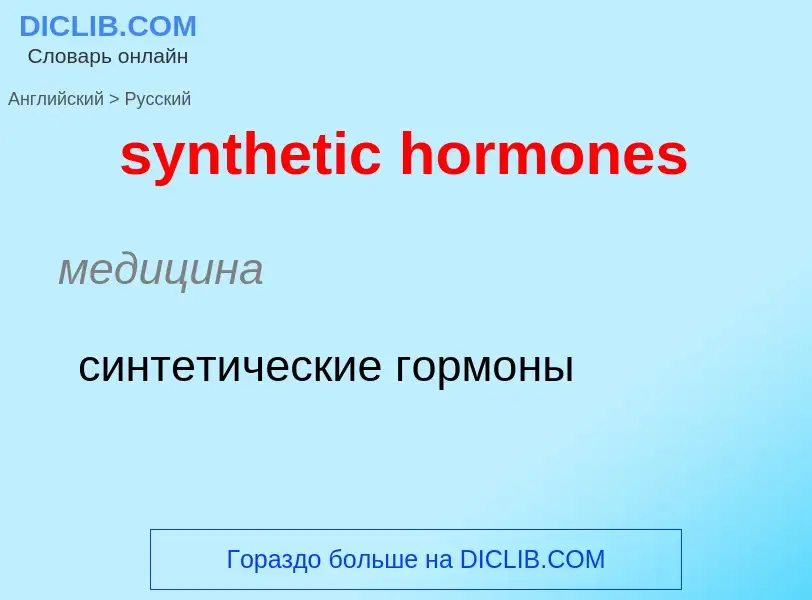Tradução e análise de palavras por inteligência artificial ChatGPT
Nesta página você pode obter uma análise detalhada de uma palavra ou frase, produzida usando a melhor tecnologia de inteligência artificial até o momento:
- como a palavra é usada
- frequência de uso
- é usado com mais frequência na fala oral ou escrita
- opções de tradução de palavras
- exemplos de uso (várias frases com tradução)
- etimologia
synthetic hormones - tradução para russo
медицина
синтетические гормоны
['hɔ:məun]
общая лексика
гормон
гормонный
медицина
инкрет (гормон)
Смотрите также
существительное
физиология
гормон
Definição
Wikipédia

A hormone (from the Greek participle ὁρμῶν, "setting in motion") is a class of signaling molecules in multicellular organisms that are sent to distant organs by complex biological processes to regulate physiology and behavior. Hormones are required for the correct development of animals, plants and fungi. Due to the broad definition of a hormone (as a signaling molecule that exerts its effects far from its site of production), numerous kinds of molecules can be classified as hormones. Among the substances that can be considered hormones, are eicosanoids (e.g. prostaglandins and thromboxanes), steroids (e.g. oestrogen and brassinosteroid), amino acid derivatives (e.g. epinephrine and auxin), protein or peptides (e.g. insulin and CLE peptides), and gases (e.g. ethylene and nitric oxide).
Hormones are used to communicate between organs and tissues. In vertebrates, hormones are responsible for regulating a variety of physiological processes and behavioral activities such as digestion, metabolism, respiration, sensory perception, sleep, excretion, lactation, stress induction, growth and development, movement, reproduction, and mood manipulation. In plants, hormones modulate almost all aspects of development, from germination to senescence.
Hormones affect distant cells by binding to specific receptor proteins in the target cell, resulting in a change in cell function. When a hormone binds to the receptor, it results in the activation of a signal transduction pathway that typically activates gene transcription, resulting in increased expression of target proteins. Hormones can also act in non-genomic pathways that synergize with genomic effects. Water-soluble hormones (such as peptides and amines) generally act on the surface of target cells via second messengers. Lipid soluble hormones, (such as steroids) generally pass through the plasma membranes of target cells (both cytoplasmic and nuclear) to act within their nuclei. Brassinosteroids, a type of polyhydroxysteroids, are a sixth class of plant hormones and may be useful as an anticancer drug for endocrine-responsive tumors to cause apoptosis and limit plant growth. Despite being lipid soluble, they nevertheless attach to their receptor at the cell surface.
In vertebrates, endocrine glands are specialized organs that secrete hormones into the endocrine signaling system. Hormone secretion occurs in response to specific biochemical signals and is often subject to negative feedback regulation. For instance, high blood sugar (serum glucose concentration) promotes insulin synthesis. Insulin then acts to reduce glucose levels and maintain homeostasis, leading to reduced insulin levels. Upon secretion, water-soluble hormones are readily transported through the circulatory system. Lipid-soluble hormones must bond to carrier plasma glycoproteins (e.g., thyroxine-binding globulin (TBG)) to form ligand-protein complexes. Some hormones, such as insulin and growth hormones, can be released into the bloodstream already fully active. Other hormones, called prohormones, must be activated in certain cells through a series of steps that are usually tightly controlled. The endocrine system secretes hormones directly into the bloodstream, typically via fenestrated capillaries, whereas the exocrine system secretes its hormones indirectly using ducts. Hormones with paracrine function diffuse through the interstitial spaces to nearby target tissue.
Plants lack specialized organs for the secretion of hormones, although there is spatial distribution of hormone production. For example, the hormone auxin is produced mainly at the tips of young leaves and in the shoot apical meristem. The lack of specialised glands means that the main site of hormone production can change throughout the life of a plant, and the site of production is dependent on the plant's age and environment.




